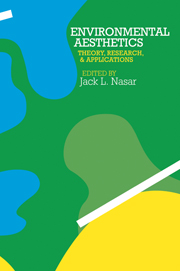Book contents
- Frontmatter
- Contents
- List of figures
- List of tables
- List of contributors and participants
- Acknowledgments
- Preface
- Section I Theory
- Section II Empirical studies
- Editor's introduction
- A Methodological comments
- B Architectural interiors
- C Architectural exteriors
- D Urban scenes
- E Natural and rural scenes
- Editor's introduction
- 22 Dimensions of meaning in the perception of natural settings and their relationship to aesthetic response
- 23 A cognitive analysis of preference for field-and-forest environments
- 24 The emotional quality of scenes and observation points: a look at prospect and refuge
- 25 Aesthetic preference for rural landscapes: some resident and visitor differences
- 26 Familiarity and preference: a cross-cultural analysis
- Section III Applications
- References
- Index of authors
- Subject index
25 - Aesthetic preference for rural landscapes: some resident and visitor differences
Published online by Cambridge University Press: 05 September 2013
- Frontmatter
- Contents
- List of figures
- List of tables
- List of contributors and participants
- Acknowledgments
- Preface
- Section I Theory
- Section II Empirical studies
- Editor's introduction
- A Methodological comments
- B Architectural interiors
- C Architectural exteriors
- D Urban scenes
- E Natural and rural scenes
- Editor's introduction
- 22 Dimensions of meaning in the perception of natural settings and their relationship to aesthetic response
- 23 A cognitive analysis of preference for field-and-forest environments
- 24 The emotional quality of scenes and observation points: a look at prospect and refuge
- 25 Aesthetic preference for rural landscapes: some resident and visitor differences
- 26 Familiarity and preference: a cross-cultural analysis
- Section III Applications
- References
- Index of authors
- Subject index
Summary
Introduction
The 1980 census revealed that the historic growth of urban areas at the expense of the rural may have reversed. Rural overpopulation and other factors, such as droughts in the Great Plains, had driven many to turn to urban areas in the search for work. Social and administrative concerns had generally been for the adjustment and adaptations of the rural migrant to the city, and for the erosion of the supposed economic and cultural advantages of urban life by pressure from increasing population (Taylor, 1968).
This situation has now changed. Planners are now faced with the pressures on rural areas brought about by an influx of newcomers, often with different needs and values from those of the existing rural residents. Few are moving to rural areas in search of work; in most cases, the motivation is for a somehow better life style. Some of these newcomers work in urban centers and commute to work. For others, the rural home is a vacation or retirement retreat. In planning for the development necessary to satisfy this increase in population, it will be necessary to weigh the values of the existing residents against those of the newcomers. This paper addresses the issue of how these two groups respond to the scenic beauty of their surroundings. The rural landscape is a mix of natural and human influences; newcomers might be expected to value the natural aspects but to dislike signs of development.
- Type
- Chapter
- Information
- Environmental AestheticsTheory, Research, and Application, pp. 364 - 378Publisher: Cambridge University PressPrint publication year: 1988
- 11
- Cited by



